In the previous two articles of this series, we looked at Minnesota’s overall voter turnout and the rise in absentee voting during the COVID-19 pandemic. For our final segment, we want to take a look at who in Minnesota has traditionally been missing at the polls – the non-voters. There are two major points at which a potential voter can be “lost”: when eligible voters do not register to vote, and when registered voters choose not to cast a ballot.
Minnesota’s voter registration rates are high…
As of the August 2020 state primary, about 85% of eligible voters in Minnesota were registered to vote. That figure exceeds the 81% who were registered before the day of the general election in 2018 (although an additional 6% registered on Election Day), and is higher than in most other states.
…but they reveal some disparities
According to the Census Bureau’s Current Population Survey, registered voters tend to be disproportionately older, whiter, and more educated than those who are not registered.
In 2016, the median age of a registered eligible voter was 51, while the median age of an unregistered eligible voter was 36. Only 80% of eligible voters under 35 reported being registered, compared to 94% of those over 65.
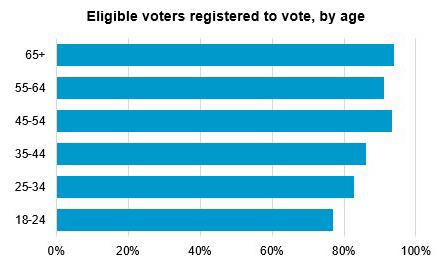
White, non-Hispanic Minnesotans were considerably more likely to be registered to vote in 2016 compared to Minnesotans of color, with 90% of eligible White voters registered, compared to 77% of eligible voters of color.
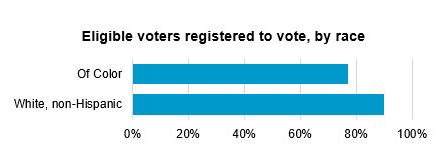
Voter registration was strongly correlated with educational attainment in 2016. Ninety-six percent of people with an associate degree or higher were registered to vote, compared to 80% of people with less than an associate degree. Higher-income Minnesotans were more likely to be registered as well.
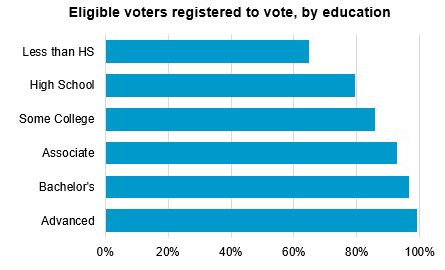
Among registered voters, there are disparities in who turns out to vote
Even among registered voters, not everyone turns out to the polls. In the 2016 election, 82% of Minnesotans who were registered to vote actually cast a ballot. Demographic disparities are visible here, too. In 2016, people with a disability were less likely to vote, as were people with lower incomes and educational attainment.
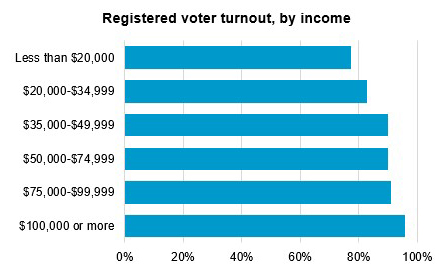

Age actually is not a meaningful predictor in this case. At least in 2016, young voters were less likely to be registered, but those who were registered turned out at about the same rate as older voters.
Racial disparities exist in both registration and voting
Disaggregating registration and voting data by race reveals some interesting patterns as well. In 2016, Black and White non-Hispanic Minnesotans reported registering to vote and casting ballots at about the same rate. However, American Indian and Asian Minnesotans both registered to vote and then cast ballots at lower rates than White and Black Minnesotans. Among Hispanic/Latino Minnesotans, registered voters voted at a similar rate to their White and Black counterparts in 2016. However, reported voter registration was dramatically lower, at 58% compared to 88% statewide, leading to low voter participation overall.
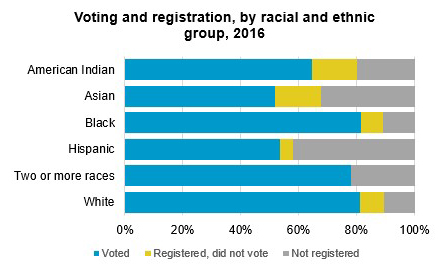
Lack of interest in, and dislike of, politics top reasons for not voting
Among Minnesotans who were not registered to vote in 2016, lack of interest in the election was the top answer given (49%) in the U.S. Census Bureau survey.
Among registered voters, the top reason given for not voting was dislike of the candidates and campaign issues (29%), followed by being too busy (14%), feeling their vote would not make a difference (13%), and illness (13%).
Although few voters in the past have listed difficulty registering or getting to the polls as their main reasons for not voting, there are concerns that those barriers may become more salient this year. COVID-19 is making it difficult to hold the kinds of large events where many new voters are registered, like graduations, new citizen ceremonies, and local festivals. Get-out-the-vote activities like door knocking are also more challenging in a time of social distancing.
However, the 2020 primary turnout shows that enthusiasm for voting remains high in Minnesota, even with the additional obstacles the pandemic presents. We hope you’ll check back with Minnesota Compass after the November election when we check in again on Minnesota’s civic engagement in this unprecedented election.
